Zack Wheeler is one of the best barrel suppressors in baseball. You might not think it, but that’s his calling card. Relative to the quality of his repertoire, he’s had a longstanding problem struggle to miss bats. For the past few years, the hope has been that Wheeler could pair elite barrel suppression with more whiffs. Injury woes are an eternal concern, but once whiffs are added to his profile, there’s not much left to do. Well, that’s exactly what he’s doing, and he’s added some called strikes too.
Wheeler has already broken out once before. He posted a 4.2 WAR season in 2018, and he followed it up with a 4.7 WAR season in 2019. He took even more of a pitch-to-contact approach in 2020 that resulted in a significant reduction in strikeouts — and this was ostensibly purposeful — but those days appear to be behind him. Wheeler has increased his strikeout percentage by more than 10% since the shortened season.
Consider just how dominant Wheeler has been thus far:
- WAR: 2nd
- K-BB%: 13th
- FIP: 5th
- xFIP: 6th
- Barrel%: 15th
This is all pretty new. You need strikeouts to be elite by K-BB%, and he hadn’t had those. You need to have a strong K-BB% to be one of the best in FIP. If fWAR is FIP-based, then we can also say that Wheeler needed the strikeouts to set himself apart as a top pitcher. At least by fWAR. That feels reductive — especially since he ranks fifth in pitcher WAR since 2018 — but it’s true. Wheeler has some new strikeouts, but where are they coming from?
There are several layers to this. Let’s start here, with Wheeler’s ten-game rolling zone-contact percentage:
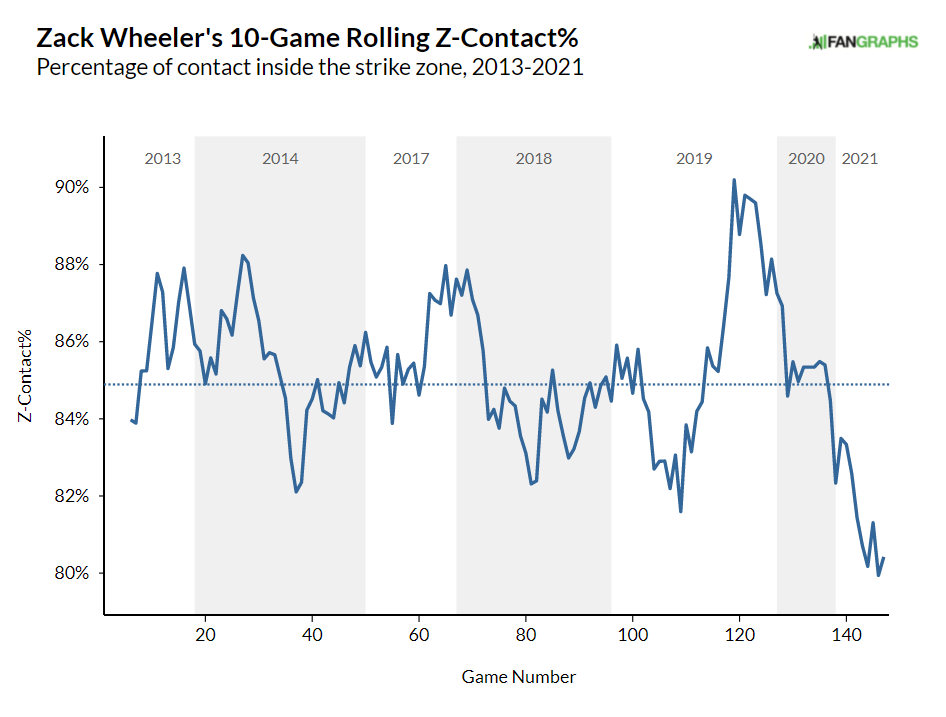
He’s never missed bats in the zone quite like this. Getting chases is great, but Wheeler’s never been able to do that. He still doesn’t do it much. That doesn’t matter so much when you can pound the zone like Wheeler and hitters still can’t make contact. He may not be elite in this regard per se, but he’s not far off either.
Here’s one of the driving forces behind his improvements in the zone. Wheeler’s pitch mix, by season:
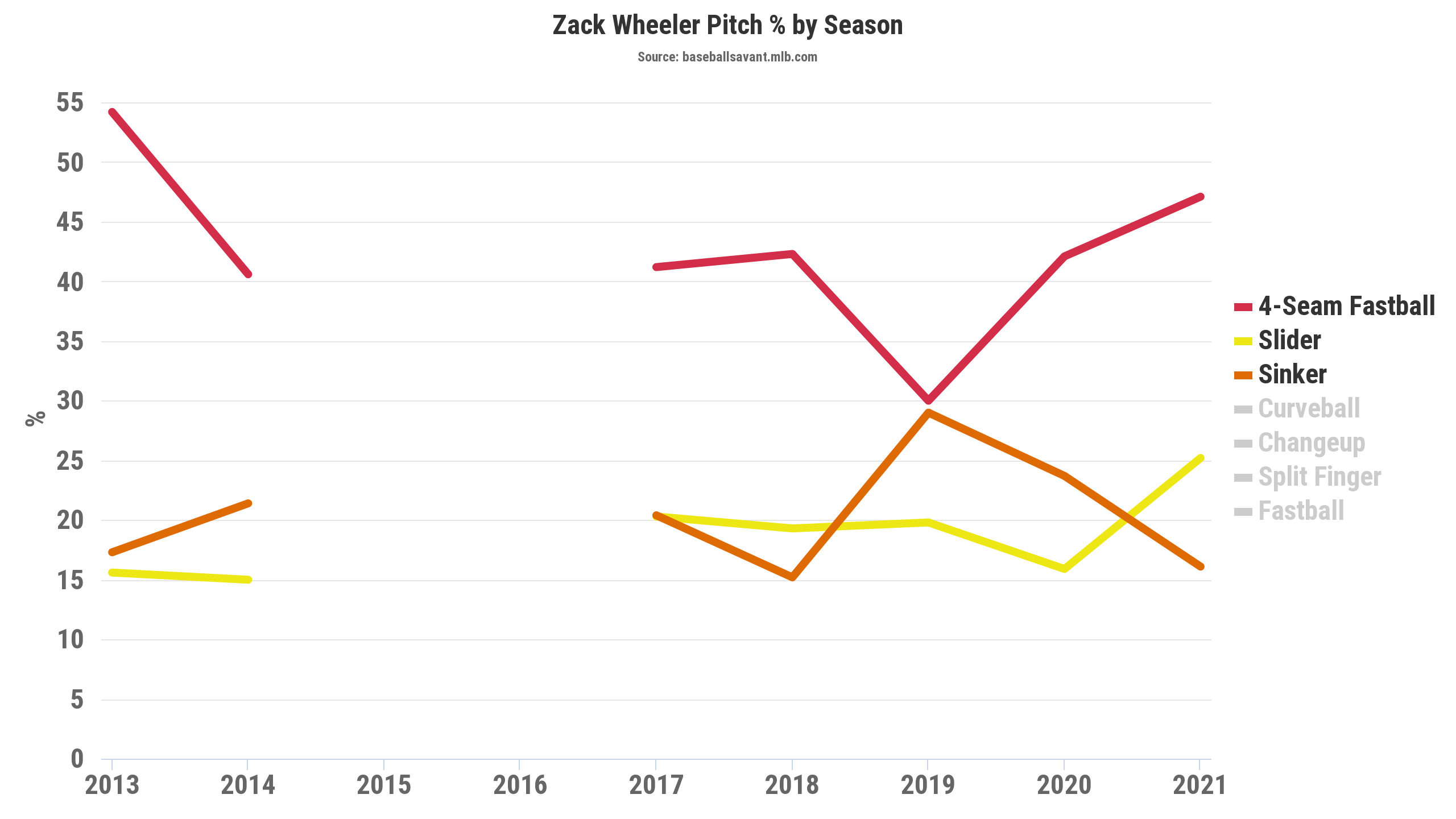
Wheeler is throwing his fastball and slider more than ever, and his sinker about as little as he ever has. Unless you count his curveball, which he uses sparsely, Wheeler’s fastball is his best strike-getting pitch. His slider is his next-best pitch, while his sinker gets put into play the most of any of his offerings. This means that Wheeler has started throwing his best strike-getters more, and he’s throwing his most contactable pitch less. That should mean fewer balls in play, which should mean that he’s pitching deeper into counts.
When considering two-strike percentage (i.e., 0-2, 1-2, and 2-2 counts), Wheeler ranks in the 84th percentile of all starters, inching out pitchers like Gerrit Cole, Corbin Burnes, and Shane Bieber. That’s up a not-insignificant amount from the 75th percentile, which is where Wheeler ranked from 2018 to 2020. That’s an improvement, and it’s played a role in his strikeout gains, but it’s not where he’s improved his game the most.
Wheeler has always been able to get to two strikes at an above-average clip. Where he hasn’t dominated so much is putting hitters away when he gets there. In two-strike counts, Wheeler has moved from the 63rd percentile from 2018 to 2020 to the 80th percentile in 2021. One way to view that is as a move from slightly above-average at finishing hitters off to well above-average. Another is that he’s surpassed 17% more of his peers in two-strike CSW.
What often gets lost in the shuffle when considering changes in pitch mix are batter handedness splits. Wheeler’s first pitch mix change is fairly common, and an awfully simple one. His pitch mix against righties, by season:
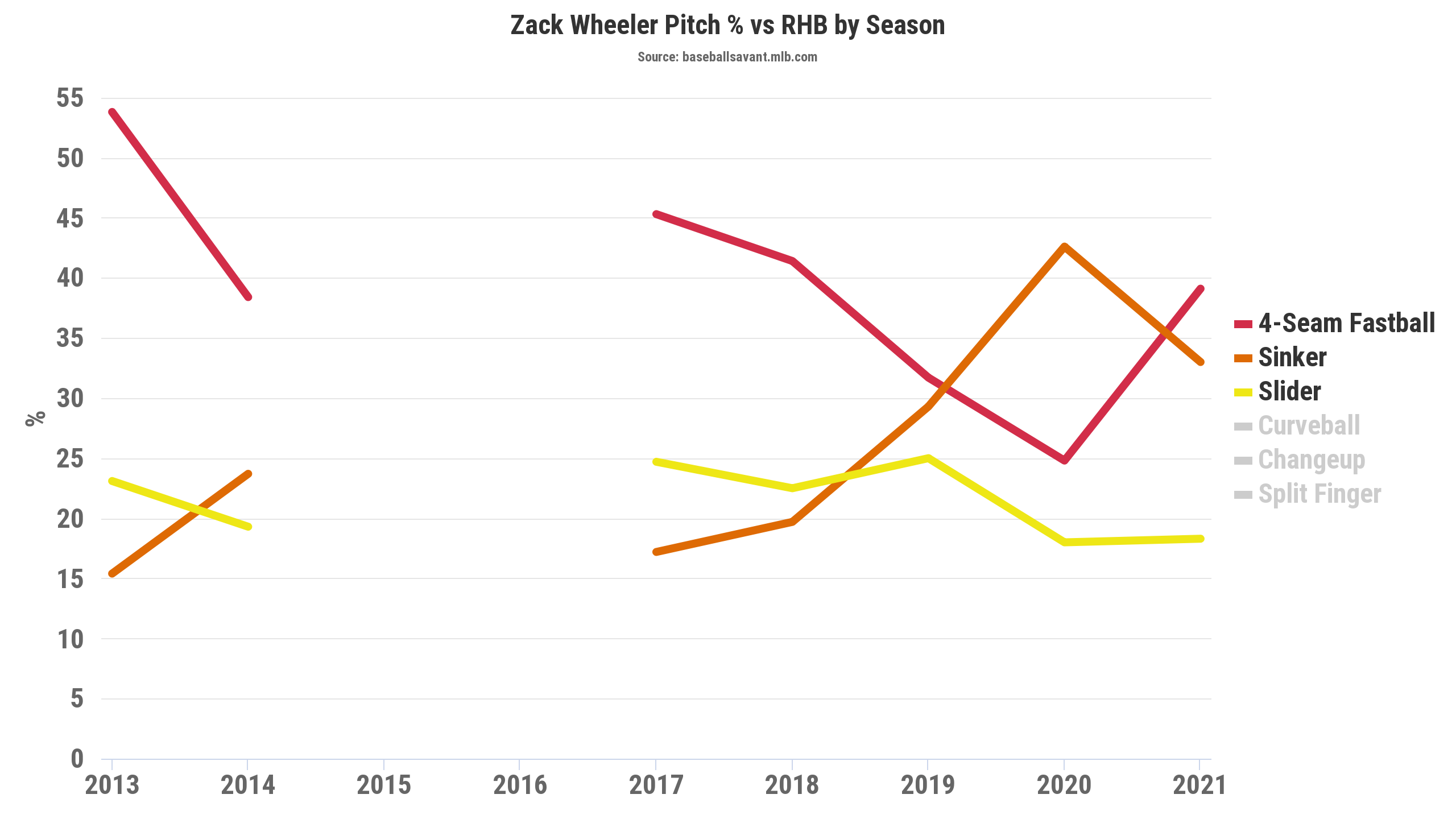
Wheeler hasn’t thrown more four-seam fastballs than sinkers since 2019. He hasn’t thrown this many fastballs against righties since 2018. Again, if you’re after strikes, this is a simple fix. Wheeler’s fastball has posted a 34.6% CSW against righties from 2018 to 2020, while his sinker posted a meager 21.1%. His sinker is great at doing what it’s supposed to do, which is to run into bats and put ground balls into play. Wheeler has just shifted to a different way of getting hitters out. The thing is, if you’re after barrel suppression, Wheeler’s four-seam fastball still might be the way to go in favor of his sinker.
In the graphic showing Wheeler’s overall pitch mix usage above, you can see a 10% increase in slider usage since last year. That bump is all coming against lefties:
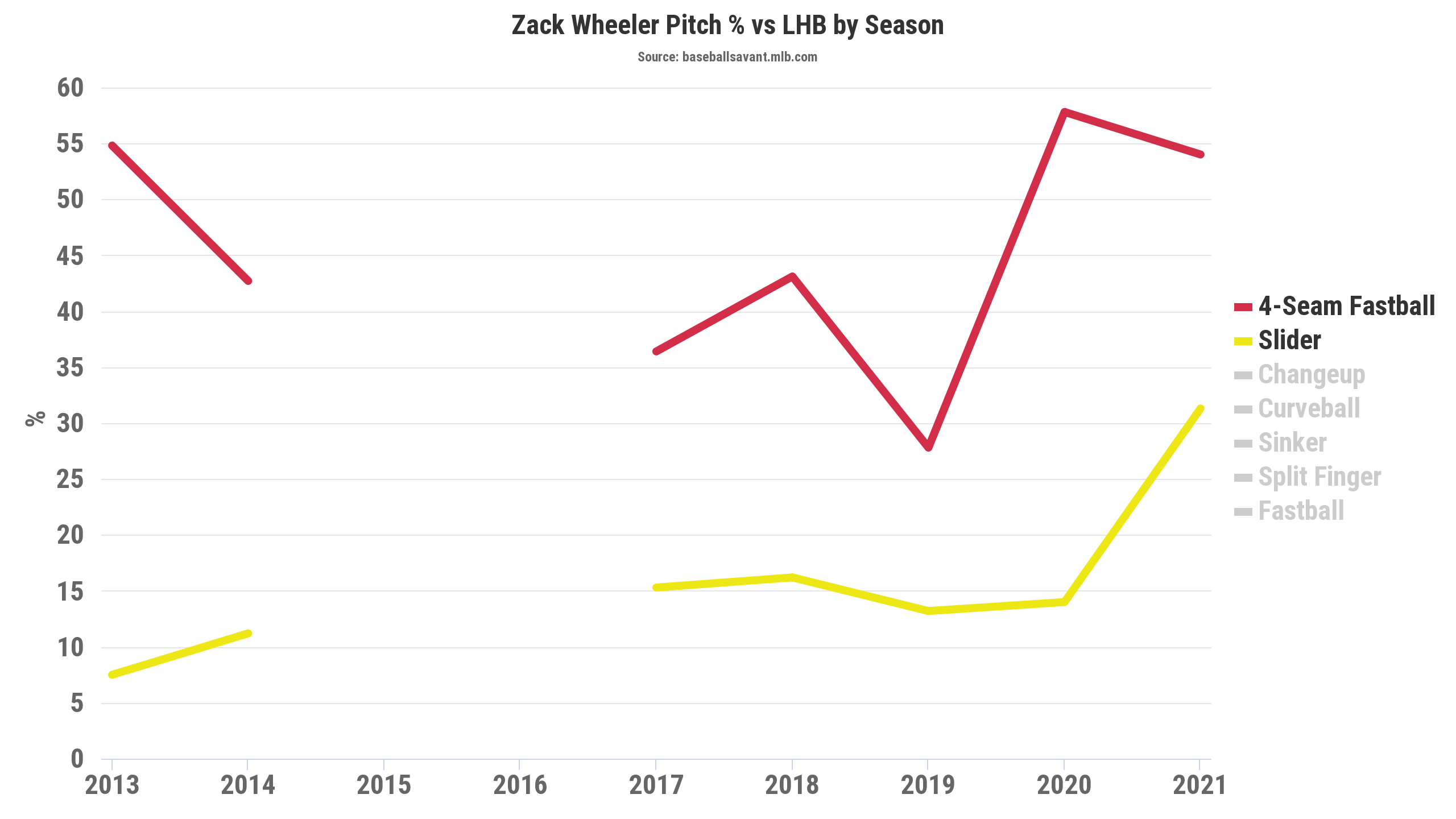
Wheeler has more than doubled the usage of his slider against left-handed hitters. Along with his curveball, it’s historically been one of his strongest offerings against lefties. Now he’s mixing it in even more than he does against righties, which gives him another strong pitch to pair with his four-seam fastball. Taking it and throwing it more was always the obvious tweak that Wheeler probably should have made all along. But Wheeler has also begun to optimize where he’s locating it too.
Take a look at his slider location versus lefties between 2018 to 2020 and 2021:
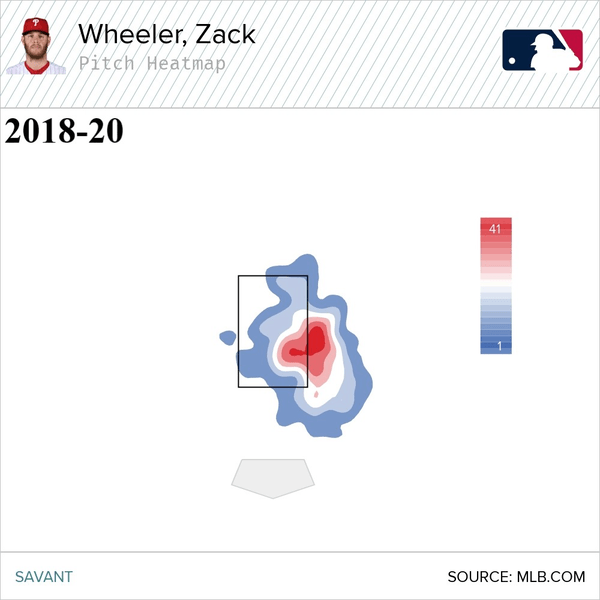
Wheeler is still locating his slider similarly on his glove-side in the vertical middle of the plate. But now he’s mixing in elevated sliders as well. Letting his sliders drift up and more arm-side has been a strike-getting boon for him, moving from a 21.2% to 30.0% CSW against lefties. It isn’t exactly common practice to elevate one’s slider — and the same can often be said about cutters — but Wheeler has done it well. He’s thrown the elevated slider more than any starting pitcher in baseball. And effectively! This newfound aptitude in throwing his slider for strikes against lefties has largely been the driver behind his overall gains in CSW, but dropping his sinker usage against righties has helped too.
So long as his current pitch mix holds, there’s no reason for me to not believe in this. I once thought that Zack Wheeler could take a leap, and it took two years, but he finally did. That’s nothing to say of the fact that there’s still more room for additional growth — I still think he has some untapped potential in his curveball — and as weird as it feels to say, it’s been a joy to watch Wheeler finally grow into an average strike-thrower.
Photo by Kyle Ross/Icon Sportswire | Adapted by Justin Paradis (@JustParaDesigns on Twitter)


Looks similar to the fangraphs article from earlier today
I think you mean that he is having a career year. He broke out in NYM.